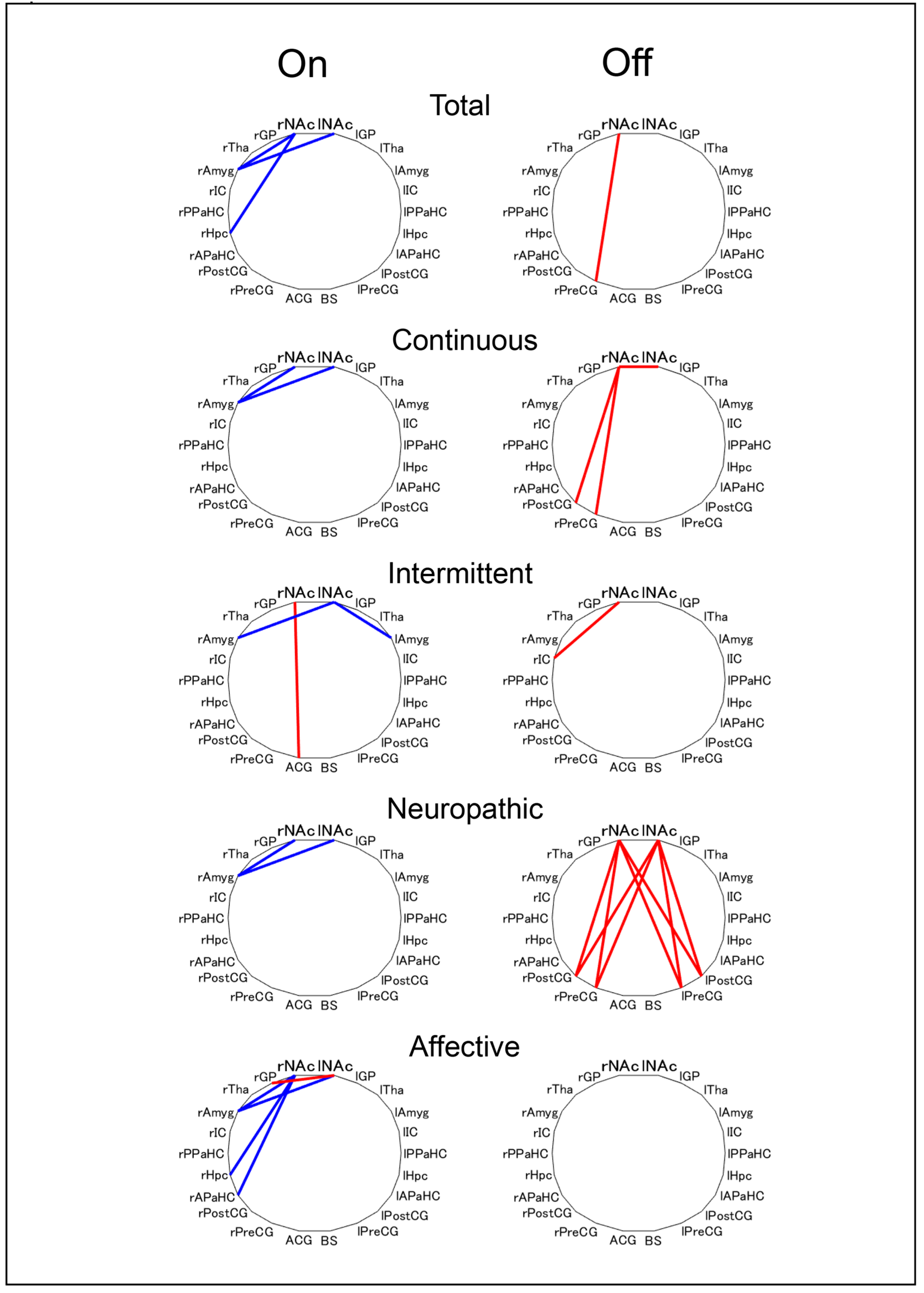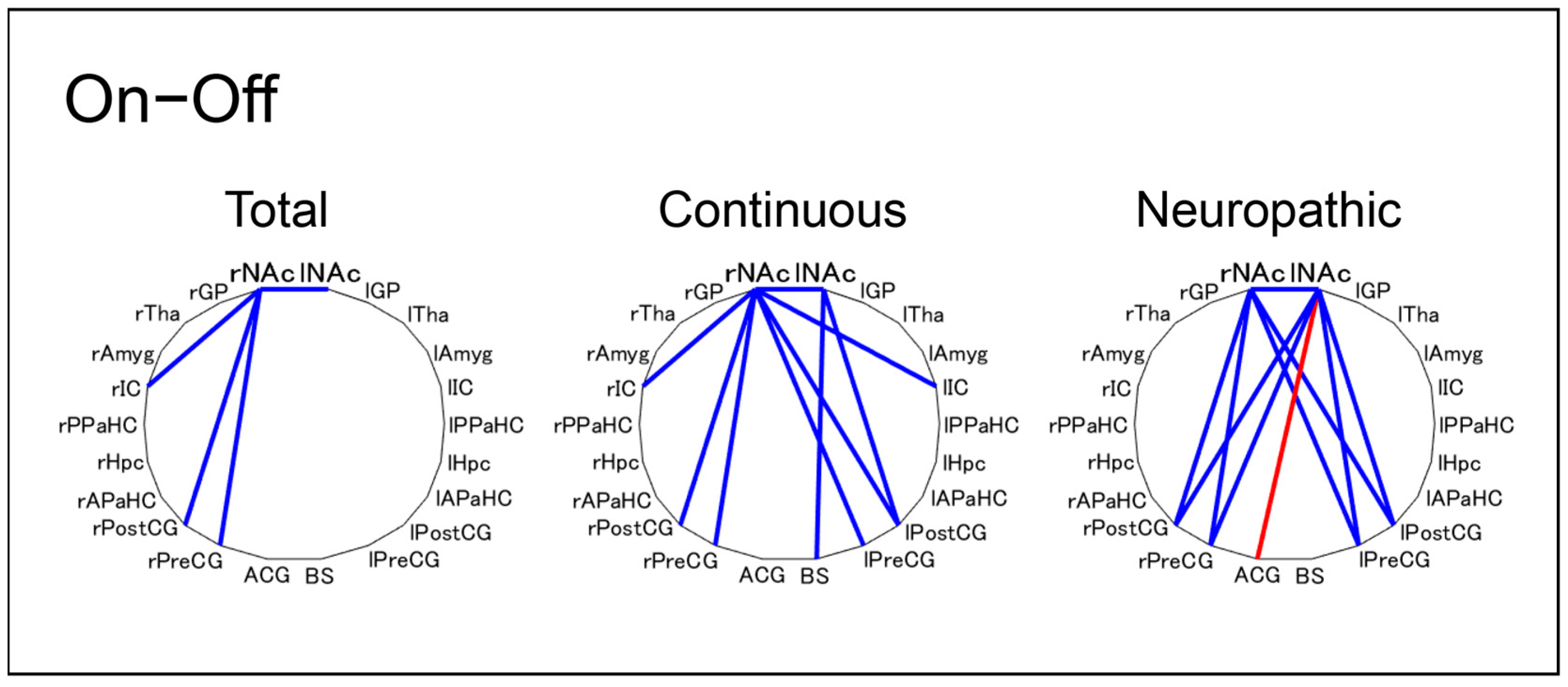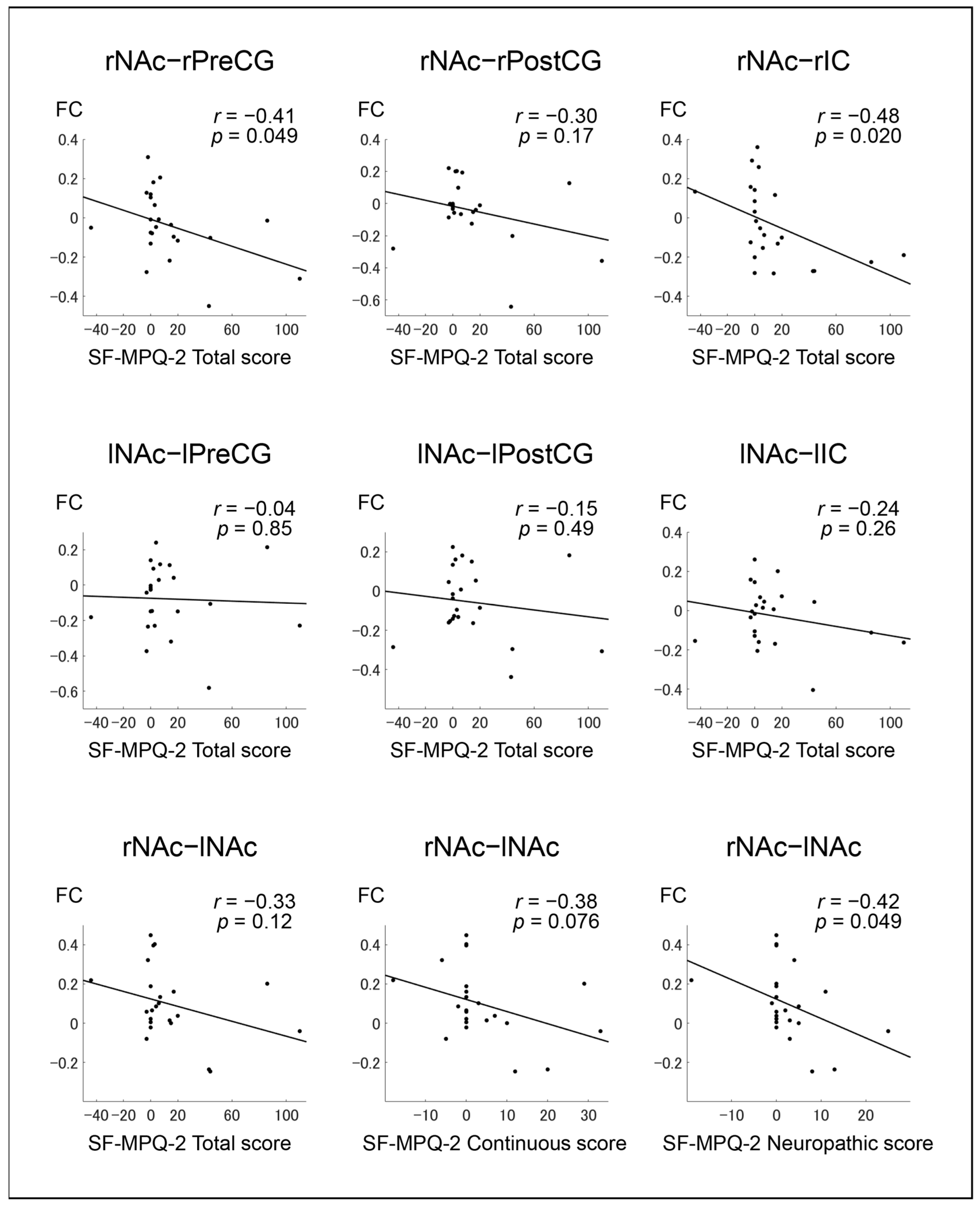Pain-Related Abnormal Neuronal Synchronization of the Nucleus Accumbens in Parkinson’s Disease
Abstract
:1. Introduction
2. Materials and Methods
2.1. Patients
2.2. Clinical Assessments and Study Design
2.3. MRI Acquisition
2.4. Functional MRI Data Preprocessing
2.5. Functional Connectivity Analysis
2.6. Statistical Analysis
3. Results
3.1. Demographic and Clinical Characteristics
3.2. Relationship between FC of the NAc and Pain Intensity in “on” and “off” States
3.3. Relationship between FC of the NAc from “on” to “off” State and Pain Intensity
3.4. Relationship between FC of the NAc from “on” to “off” State and Pain Developing from “on” to “off” State
4. Discussion
5. Conclusions
Supplementary Materials
Author Contributions
Funding
Institutional Review Board Statement
Informed Consent Statement
Data Availability Statement
Conflicts of Interest
References
- Lim, S.Y.; Lang, A.E. The Nonmotor Symptoms of Parkinson’s Disease—An Overview. Mov. Disord. 2010, 25 (Suppl. 1), S123–S130. [Google Scholar] [CrossRef]
- Beiske, A.G.; Loge, J.H.; Ronningen, A.; Svensson, E. Pain in Parkinson’s Disease: Prevalence and Characteristics. Pain 2009, 141, 173–177. [Google Scholar] [CrossRef] [PubMed]
- Ford, B. Pain in Parkinson’s Disease. Mov. Disord. 2010, 25, S98–S103. [Google Scholar] [CrossRef] [PubMed]
- Nebe, A.; Ebersbach, G. Pain Intensity on and off Levodopa in Patients with Parkinson’s Disease. Mov. Disord. 2009, 24, 1233–1237. [Google Scholar] [CrossRef] [PubMed]
- Yang, S.; Boudier-Reveret, M.; Choo, Y.J.; Chang, M.C. Association Between Chronic Pain and Alterations in the Mesolimbic Dopaminergic System. Brain Sci. 2020, 10, 701. [Google Scholar] [CrossRef] [PubMed]
- Benarroch, E.E. Involvement of the Nucleus Accumbens and Dopamine System in Chronic Pain. Neurology 2016, 87, 1720–1726. [Google Scholar] [CrossRef]
- Shine, J.M.; Bell, P.T.; Matar, E.; Poldrack, R.A.; Lewis, S.J.G.; Halliday, G.M.; O’Callaghan, C. Dopamine Depletion Alters Macroscopic Network Dynamics in Parkinson’s Disease. Brain 2019, 142, 1024–1034. [Google Scholar] [CrossRef]
- Engels, G.; McCoy, B.; Vlaar, A.; Theeuwes, J.; Weinstein, H.; Scherder, E.; Douw, L. Clinical Pain and Functional Network Topology in Parkinson’s Disease: A Resting-State fMRI Study. J. Neural Transm. 2018, 125, 1449–1459. [Google Scholar] [CrossRef] [Green Version]
- Harris, H.N.; Peng, Y.B. Evidence and Explanation for the Involvement of the Nucleus Accumbens in Pain Processing. Neural Regen Res. 2020, 15, 597–605. [Google Scholar] [CrossRef]
- Kinugawa, K.; Mano, T.; Sugie, K. Neuronal Dynamics of Pain in Parkinson’s Disease. Brain Sci. 2021, 11, 1224. [Google Scholar] [CrossRef]
- Maruo, T.; Nakae, A.; Maeda, L.; Takahashi–Narita, K.; Morris, S.; Yokoe, M.; Matsuzaki, T.; Shibata, M.; Saitoh, Y. Translation and Reliability and Validity of a Japanese Version of the Revised Short–Form McGill Pain Questionnaire (SF–MPQ–2). Pain Res. 2013, 28, 43–53. [Google Scholar] [CrossRef] [Green Version]
- Daniel, S.E.; Lees, A.J. Parkinson’s Disease Society Brain Bank, London: Overview and Research. J. Neural Transm. Suppl. 1993, 39, 165–172. [Google Scholar]
- Goetz, C.G.; Tilley, B.C.; Shaftman, S.R.; Stebbins, G.T.; Fahn, S.; Martinez-Martin, P.; Poewe, W.; Sampaio, C.; Stern, M.B.; Dodel, R.; et al. Movement Disorder Society-Sponsored Revision of the Unified Parkinson’s Disease Rating Scale (MDS-UPDRS): Scale Presentation and Clinimetric Testing Results. Mov. Disord. 2008, 23, 2129–2170. [Google Scholar] [CrossRef]
- Hartrick, C.T.; Kovan, J.P.; Shapiro, S. The Numeric Rating Scale for Clinical Pain Measurement: A Ratio Measure? Pain Pr. 2003, 3, 310–316. [Google Scholar] [CrossRef]
- Takemoto, M.; Sato, K.; Hatanaka, N.; Yamashita, T.; Ohta, Y.; Hishikawa, N.; Abe, K. Different Clinical and Neuroimaging Characteristics in Early Stage Parkinson’s Disease with Dementia and Dementia with Lewy Bodies. J. Alzheimer’s Dis. 2016, 52, 205–211. [Google Scholar] [CrossRef] [Green Version]
- Tomlinson, C.L.; Stowe, R.; Patel, S.; Rick, C.; Gray, R.; Clarke, C.E. Systematic Review of Levodopa Dose Equivalency Reporting in Parkinson’s Disease. Mov. Disord. 2010, 25, 2649–2653. [Google Scholar] [CrossRef] [PubMed]
- Barkhof, F.; Haller, S.; Rombouts, S.A. Resting-State Functional MR Imaging: A New Window to the Brain. Radiology 2014, 272, 29–49. [Google Scholar] [CrossRef]
- Whitfield-Gabrieli, S.; Nieto-Castanon, A. Conn: A Functional Connectivity Toolbox for Correlated and Anticorrelated Brain Networks. Brain Connect. 2012, 2, 125–141. [Google Scholar] [CrossRef] [PubMed] [Green Version]
- Burns, E.; Chipchase, L.S.; Schabrun, S.M. Primary Sensory and Motor Cortex Function in Response to Acute Muscle Pain: A Systematic Review and Meta-Analysis. Eur. J. Pain 2016, 20, 1203–1213. [Google Scholar] [CrossRef]
- Sun, X.; Pan, X.; Ni, K.; Ji, C.; Wu, J.; Yan, C.; Luo, Y. Aberrant Thalamic-Centered Functional Connectivity in Patients with Persistent Somatoform Pain Disorder. Neuropsychiatr. Dis. Treat. 2020, 16, 273–281. [Google Scholar] [CrossRef] [Green Version]
- Polli, A.; Weis, L.; Biundo, R.; Thacker, M.; Turolla, A.; Koutsikos, K.; Chaudhuri, K.R.; Antonini, A. Anatomical and Functional Correlates of Persistent Pain in Parkinson’s Disease. Mov. Disord. 2016, 31, 1854–1864. [Google Scholar] [CrossRef]
- Tu, Y.; Jung, M.; Gollub, R.L.; Napadow, V.; Gerber, J.; Ortiz, A.; Lang, C.; Mawla, I.; Shen, W.; Chan, S.T.; et al. Abnormal Medial Prefrontal Cortex Functional Connectivity and its Association with Clinical Symptoms in Chronic Low Back Pain. Pain 2019, 160, 1308–1318. [Google Scholar] [CrossRef]
- Pahwa, R.; Lyons, K.E. Levodopa-Related Wearing-off in Parkinson’s Disease: Identification and Management. Curr. Med. Res. Opin. 2009, 25, 841–849. [Google Scholar] [CrossRef]
- Franke, C.; Storch, A. Nonmotor Fluctuations in Parkinson’s Disease. Int. Rev. Neurobiol. 2017, 134, 947–971. [Google Scholar] [CrossRef] [PubMed]
- Storch, A.; Schneider, C.B.; Wolz, M.; Sturwald, Y.; Nebe, A.; Odin, P.; Mahler, A.; Fuchs, G.; Jost, W.H.; Chaudhuri, K.R.; et al. Nonmotor Fluctuations in Parkinson Disease: Severity and Correlation with Motor Complications. Neurology 2013, 80, 800–809. [Google Scholar] [CrossRef] [PubMed]
- Gee, T.A.; Weintraub, N.C.; Lu, D.; Phelps, C.E.; Navratilova, E.; Heien, M.L.; Porreca, F. A Pain-Induced Tonic Hypodopaminergic State Augments Phasic Dopamine Release in the Nucleus Accumbens. Pain 2020, 161, 2376–2384. [Google Scholar] [CrossRef] [PubMed]
- Serafini, R.A.; Pryce, K.D.; Zachariou, V. The Mesolimbic Dopamine System in Chronic Pain and Associated Affective Comorbidities. Biol. Psychiatry 2020, 87, 64–73. [Google Scholar] [CrossRef] [Green Version]
- Chang, P.C.; Pollema-Mays, S.L.; Centeno, M.V.; Procissi, D.; Contini, M.; Baria, A.T.; Martina, M.; Apkarian, A.V. Role of Nucleus Accumbens in Neuropathic Pain: Linked Multi-Scale Evidence in the Rat Transitioning to Neuropathic Pain. Pain 2014, 155, 1128–1139. [Google Scholar] [CrossRef] [Green Version]
- Shine, J.M.; Halliday, G.M.; Gilat, M.; Matar, E.; Bolitho, S.J.; Carlos, M.; Naismith, S.L.; Lewis, S.J. The Role of Dysfunctional Attentional Control Networks in Visual Misperceptions in Parkinson’s Disease. Hum. Brain Mapp. 2014, 35, 2206–2219. [Google Scholar] [CrossRef]
- Brakowski, J.; Spinelli, S.; Dorig, N.; Bosch, O.G.; Manoliu, A.; Holtforth, M.G.; Seifritz, E. Resting State Brain Network Function in Major Depression–Depression Symptomatology, Antidepressant Treatment Effects, Future Research. J. Psychiatr. Res. 2017, 92, 147–159. [Google Scholar] [CrossRef]



| PD (n = 23) | p-Value | ||
|---|---|---|---|
| Age | 73.04 ± 7.96 | ||
| Sex | 12 Male/11 Female | ||
| Disease Duration, years | 10.13 ± 6.68 | ||
| LEDD, mg | 676.65 ± 272.55 | ||
| H-Y stages | |||
| H-Y II | 4 (17.4%) | ||
| H-Y III | 8 (34.8%) | ||
| H-Y IV | 9 (39.1%) | ||
| H-Y V | 2 (8.7%) | ||
| MDS-UPDRS | |||
| Total | On | Off | <0.05 |
| 63.56 ± 31.55 | 77.48 ± 33.52 | ||
| Part I | 13.91 ± 7.66 | ||
| Part II | 16.61 ± 10.07 | ||
| Part III | On | Off | <0.05 |
| 25.65 ± 15.38 | 40.35 ± 18.29 | ||
| Part IV | 7.26 ± 3.92 | ||
| NRS | On | Off | 0.068 |
| 2.61 ± 1.83 | 2.87 ± 3.21 | ||
| SF-MPQ-2 | On | Off | |
| Total | 10.91 ± 23.14 | 24.83 ± 34.38 | <0.05 |
| Continuous | 10.91 ± 23.14 | 24.83 ± 34.83 | 0.11 |
| Intermittent | 1.78 ± 4.24 | 5.22 ± 10.25 | 0.12 |
| Neuropathic | 2.70 ± 7.65 | 5.26 ± 8.62 | 0.12 |
| Affective | 2.26 ± 4.18 | 6.35 ± 9.85 | <0.05 |
| MMSE score | 24.74 ± 3.83 | ||
| HDSR score | 24.57 ± 4.33 | ||
| FAB score | 12.61 ± 2.73 | ||
Publisher’s Note: MDPI stays neutral with regard to jurisdictional claims in published maps and institutional affiliations. |
© 2022 by the authors. Licensee MDPI, Basel, Switzerland. This article is an open access article distributed under the terms and conditions of the Creative Commons Attribution (CC BY) license (https://creativecommons.org/licenses/by/4.0/).
Share and Cite
Kinugawa, K.; Mano, T.; Yamatani, Y.; Miyasaka, T.; Kataoka, H.; Sugie, K. Pain-Related Abnormal Neuronal Synchronization of the Nucleus Accumbens in Parkinson’s Disease. Brain Sci. 2022, 12, 84. https://doi.org/10.3390/brainsci12010084
Kinugawa K, Mano T, Yamatani Y, Miyasaka T, Kataoka H, Sugie K. Pain-Related Abnormal Neuronal Synchronization of the Nucleus Accumbens in Parkinson’s Disease. Brain Sciences. 2022; 12(1):84. https://doi.org/10.3390/brainsci12010084
Chicago/Turabian StyleKinugawa, Kaoru, Tomoo Mano, Yuya Yamatani, Toshiteru Miyasaka, Hiroshi Kataoka, and Kazuma Sugie. 2022. "Pain-Related Abnormal Neuronal Synchronization of the Nucleus Accumbens in Parkinson’s Disease" Brain Sciences 12, no. 1: 84. https://doi.org/10.3390/brainsci12010084






